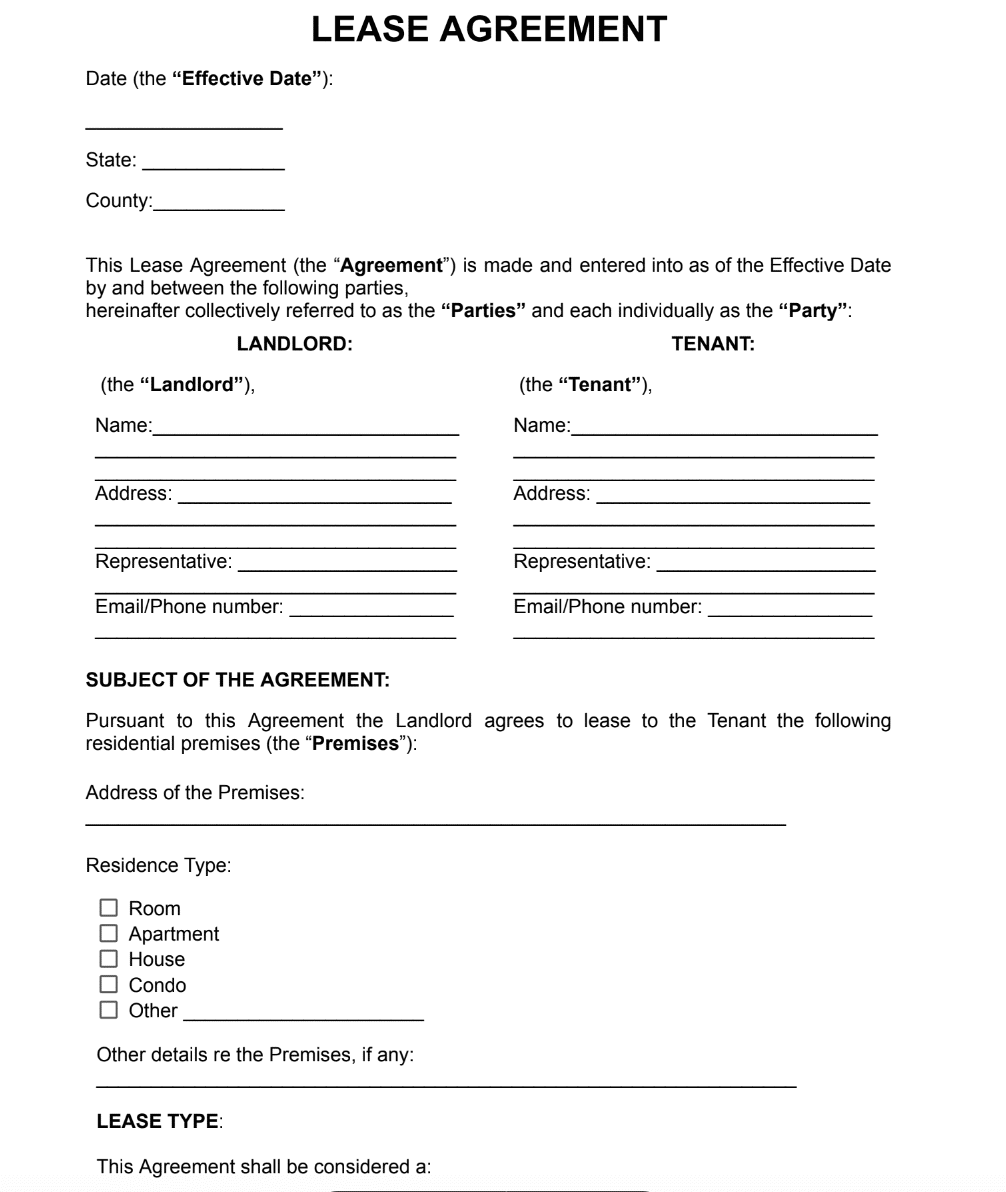 Preview
Preview

A lease agreement outlines the relationship between a property owner and a tenant. Using a free lease agreement template can establish a smooth landlord-tenant relationship. Such a document clearly defines the rights, responsibilities, and limitations each party must adhere to, thus preventing misunderstandings and potential conflicts.
A well-drafted lease agreement made using a free lease agreement template can go a long way toward supporting a harmonious relationship between landlords and tenants.
Lease agreements can take various forms, depending on factors like the type of property being leased and the intended duration of the lease. Some of the most common types of lease agreements include:
Using a free template for lease agreements can be a practical option for landlords when creating such documents.
Even though we often use “lease agreement” and “rental agreement” in the same way, it’s important to know their differences.
A rental “lease agreement” sets fixed rules for renting a property for a prolonged time, often six months or longer. During this time, critical details like rent cost and the lease term cannot be easily changed or stopped by either party.
Having an ultimate lease agreement form benefits both landlords and tenants. Landlords can expect a steady income for the lease, and tenants can occupy the property without worrying about sudden changes.
In contrast, a “rental contract” typically caters to shorter, usually month-to-month arrangements, which gives the contract its inherent flexibility. The landlord and tenant can alter the terms or terminate the agreement, provided they give proper notice, often 30 days.
The flexibility of the rental agreement template free of charge can be especially appealing to temporary workers, students, or people with less predictable plans. For the landlord, it allows for potential adjustments to terms, such as rent increases, to align with fluctuating market conditions.
While both types of agreements maintain the landlord-tenant relationship, deciding between a lease agreement and a rental agreement form depends on both parties’ specific needs and goals.
A lease agreement, or alternatively, a rental agreement template, is crucial in renting out a property in various situations. Such a template often becomes necessary for drafting a detailed and comprehensive agreement.
Here are some circumstances when using a free rental agreement template becomes essential when establishing a lease:
A lease agreement involves at least two parties: the “landlord” (property owner) and the “tenant” (the one willing to rent the property). Also, the agreement contains several key terms critical to understanding the lease. These include:
Creating a lease agreement can be straightforward, especially using a free template. Here’s a step-by-step guide to help you get started:
Step 1: Choose a lease agreement template
For individuals wishing to rent a property, a lease agreement template free of charge can be an invaluable tool in streamlining the process. Start by selecting a lease agreement template to guide you through the necessary clauses and language required for a comprehensive lease.
Step 2: Specify the parties involved
Write down all the details of the parties involved in the lease agreement. This includes the “landlord” (property owner) and the “tenant” (the individual or company renting the property). Even free printable lease agreements have this part at the beginning of the document.
Step 3: Detail the property
Describe the property being leased. This might include the address, the type of property (residential, commercial, or ground lease), and any features or fixtures included.
Step 4: Determine lease terms
The next step is to determine and outline the key terms of your lease, including lease duration, rental amount, payment schedule, and security deposit details.
Step 5: Explain responsibilities
Specify responsibilities for the upkeep of the property. This includes repair and maintenance duties and who will handle them.
Step 6: Outline lease termination or renewal conditions
Clearly explain the circumstances under which the lease could be terminated or renewed. This would include notice periods and any potential penalties.
Step 7: Review the agreement
Before signing, both parties should thoroughly review the agreement to ensure a complete understanding and mutual agreement on all specified terms.
Step 8: Sign and distribute copies
In the end, the landlord and tenant need to sign the lease. It is essential for each party to keep a signed copy for future reference. It’s good to store this copy somewhere safe and easy to find. This way, both parties can check the agreement in case of issues or confusion later.
A well-structured lease agreement is critical for any property rental situation, bringing security and peace of mind to landlords and tenants. It allows everyone involved to set clear expectations from the beginning, which can lead to a more harmonious and productive leasing relationship.
For those looking for a safe and fast way to get a rental lease agreement, PDF may be the right format – you may pick one available online or on this website. Whether renting out your property or looking to find a place to stay, using a lease agreement template can help you start the process right.
 Preview
Preview
